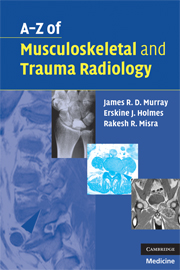Book contents
- Frontmatter
- Contents
- Acknowledgements
- Preface
- List of abbreviations
- Section I Musculoskeletal radiology
- Achilles tendonopathy/rupture
- Aneurysmal bone cysts
- Ankylosing spondylitis
- Avascular necrosis – osteonecrosis
- Femoral-head osteonecrosis
- Kienböck's disease
- Back pain – including spondylolisthesis/spondylolysis
- Bone cysts
- Bone infarcts (medullary)
- Charcot joint (neuropathic joint)
- Complex regional-pain syndrome
- Crystal deposition disorders
- Developmental dysplasia of the hip (DDH)
- Discitis and vertebral osteomyelitis
- Disc prolapse – PID – ‘slipped discs’ and sciatica
- Diffuse idiopathic skeletal hyperostosis (DISH)
- Dysplasia – developmental disorders
- Enthesopathy
- Gout
- Haemophilia
- Hyperparathyroidism
- Hypertrophic pulmonary osteoarthropathy
- Irritable hip/transient synovitis
- Juvenile idiopathic arthritis
- Langerhans-cell histiocytosis
- Lymphoma of bone
- Metastases to bone
- Multiple myeloma
- Myositis ossificans
- Non-accidental injury
- Osteoarthrosis – osteoarthritis
- Osteochondroses
- Osteomyelitis (acute)
- Osteoporosis
- Paget's disease
- Perthes disease
- Pigmented villonodular synovitis (PVNS)
- Psoriatic arthropathy
- Renal osteodystrophy (including osteomalacia)
- Rheumatoid arthritis
- Rickets
- Rotator-cuff disease
- Scoliosis
- Scheuermann's disease
- Septic arthritis – native and prosthetic joints
- Sickle-cell anaemia
- Slipped upper femoral epiphysis (SUFE)
- Tendinopathy – tendonitis
- Tuberculosis
- Tumours of bone (benign and malignant)
- Section II Trauma radiology
Developmental dysplasia of the hip (DDH)
from Section I - Musculoskeletal radiology
Published online by Cambridge University Press: 22 August 2009
- Frontmatter
- Contents
- Acknowledgements
- Preface
- List of abbreviations
- Section I Musculoskeletal radiology
- Achilles tendonopathy/rupture
- Aneurysmal bone cysts
- Ankylosing spondylitis
- Avascular necrosis – osteonecrosis
- Femoral-head osteonecrosis
- Kienböck's disease
- Back pain – including spondylolisthesis/spondylolysis
- Bone cysts
- Bone infarcts (medullary)
- Charcot joint (neuropathic joint)
- Complex regional-pain syndrome
- Crystal deposition disorders
- Developmental dysplasia of the hip (DDH)
- Discitis and vertebral osteomyelitis
- Disc prolapse – PID – ‘slipped discs’ and sciatica
- Diffuse idiopathic skeletal hyperostosis (DISH)
- Dysplasia – developmental disorders
- Enthesopathy
- Gout
- Haemophilia
- Hyperparathyroidism
- Hypertrophic pulmonary osteoarthropathy
- Irritable hip/transient synovitis
- Juvenile idiopathic arthritis
- Langerhans-cell histiocytosis
- Lymphoma of bone
- Metastases to bone
- Multiple myeloma
- Myositis ossificans
- Non-accidental injury
- Osteoarthrosis – osteoarthritis
- Osteochondroses
- Osteomyelitis (acute)
- Osteoporosis
- Paget's disease
- Perthes disease
- Pigmented villonodular synovitis (PVNS)
- Psoriatic arthropathy
- Renal osteodystrophy (including osteomalacia)
- Rheumatoid arthritis
- Rickets
- Rotator-cuff disease
- Scoliosis
- Scheuermann's disease
- Septic arthritis – native and prosthetic joints
- Sickle-cell anaemia
- Slipped upper femoral epiphysis (SUFE)
- Tendinopathy – tendonitis
- Tuberculosis
- Tumours of bone (benign and malignant)
- Section II Trauma radiology
Summary
Characteristics
Previously known as congenital dislocation of the hip (CDH), but now recognised as a developmental failure of the acetabulum around the femoral head.
A dysplastic acetabulum is shallow and ‘vertical’ rather than concentrically covering the femoral head. This allows an increased degree of instability in the hip joint which, in extreme cases, presents as frank dislocation of the hip. However, this is a spectrum of disease and DDH often has a bearing on the aetiology of early adult hip OA.
Female : male ratio of 7:1. Left hip more commonly affected than right; bilateral in 20% cases.
The reported incidence of neonatal hip instability is 5–20/1000 live births, but following re-examination 6 weeks later, the incidence falls to 1–2/1000 infants.
Risk factors include family history (including maternal/sibling DDH, joint laxity and shallow acetabulae), breech presentation, oligohydramnios, other developmental anomalies, high levels of oestrogen, progesterone and relaxin in the last few weeks of pregnancy, and cultural post-natal factors (swaddling increases the risk, e.g. North American Indians, whereas encouraging legs to be widely abducted to allow sitting astride the back, as in southern Chinese and certain African peoples, decreases the risk of DDH).
Clinical features
Neonatal diagnosis is the gold standard. Look for decreased abduction in flexion, unequal gluteal and groin folds (only a ‘soft sign’ though) and an apparently short femur (Galleazzi test), but beware bilateral DDH.
Ortolani test – the dislocated or subluxed hip (out) is relocated (in flexion and abduction) by ‘lifting up’ with pressure on the greater trochanter.
Barlow's test looks for instability by pushing back (i.e. posterior) in the flexed hip.
[…]
- Type
- Chapter
- Information
- A-Z of Musculoskeletal and Trauma Radiology , pp. 41 - 44Publisher: Cambridge University PressPrint publication year: 2008

